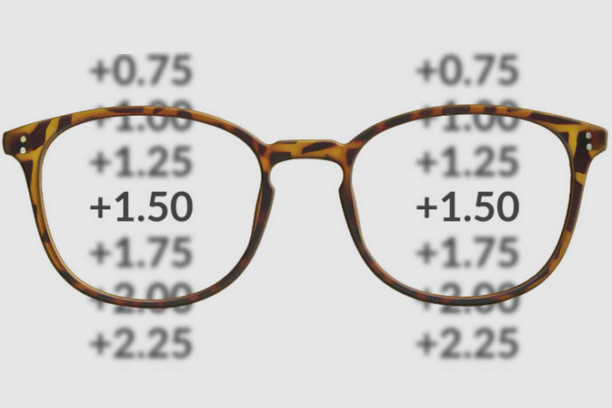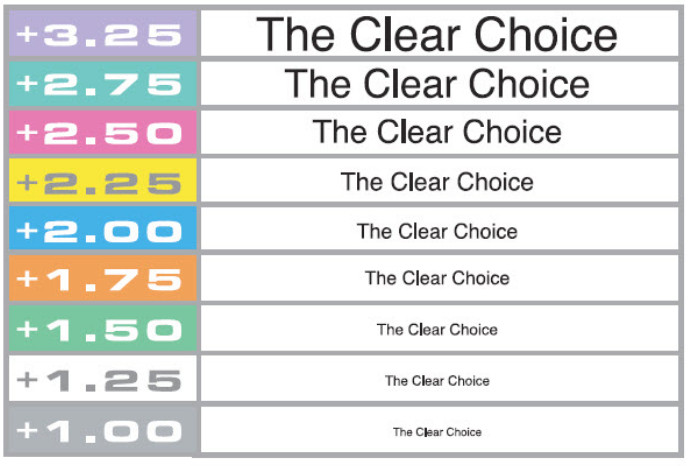- GlassesShop By FrameShop By StyleFeatured












Choosing the right reading glasses for comfort and good vision is crucial
because they make reading easier and more enjoyable and this article will
explain how to select reading glasses that fit comfortably and don't cause eye
strain when reading text. We'll give a strength chart breakdown to make it
simpler to identify the glasses that meet your vision needs. Armed with this
knowledge, you can select reading glasses that will improve your reading
experience in addition to looking great.

Individuals who have problems seeing small print, get headaches or eye strain when looking up close, or who have both of these problems, are more likely to start wearing reading glasses because these specialized eyewear are designed to improve near vision and is not intended for long-distance viewing.If you find that objects are easier to see when held farther away or if reading in strong light still makes your eyes tired, you might need to purchase reading glasses. These are classic indicators that your eyes need a little assistance when working up close. Having reading glasses can significantly improve your comfort level and ease the strain on your eyes during close tasks like reading.
The strength of reading glasses is expressed in diopters, which indicates the minimum strength required for assistance with close object focus. The degree of correction offered by the glasses increases with the diopter. To better grasp what each strength may accomplish for your vision, consider that simple chart:

+1.00 diopters Good for people who just started needing help with very small print
+1.50 diopters Best for reading small text without straining.
+2.00 diopters For those needing more help to see clearly up close.
+2.50 diopters Helps if you find it quite hard to read up close without glasses.
+3.00 diopters For people who need a lot of help to see things clearly at a close distance.
Using this chart, you can select the appropriate strength according to the amount of correction your eyes require; nonetheless, it's advisable to consult an ophthalmologist to determine the best option for you.
As simple as it may appear, choosing the appropriate strength for your reading glasses is actually rather easy. Printing out a reading chart is a perfect way to start because it allows you to practice reading text at different sizes while maintaining a comfortable reading distance. If you find that smaller text is unclear, try larger text until you reach a clear size. This will help you determine how much intensity you might need. Also, must test each eye separately because both may not require the same strength.
Selecting glasses frames that enhance your face's contour is essential when picking the perfect reading glasses. For example, square frames can make a round face appear longer. Comfort and style are just as important as strength in this decision. Also, consider your lifestyle and personal style as well. For example, if you have a busy lifestyle, look for durable and flexible frames.It can be easier to see or use a computer with features like anti-reflective coatings that lessen glare from screens and bright lights. In addition, some glasses have flexible frames, which are fantastic since they are less likely to break, and UV protection, which shields your eyes from damaging sun rays, is vital if you plan to read outside.Remember that the best glasses fit well, look well on you, and have features that fulfil your reading demands, so taking the time to select the correct pair will make reading more joyful and comfortable.

Choose reading glasses strength “by age”
⇥ Age 40-44 – Recommended power +0.75 to +1.00 diopter.
⇥ Age 45-49 – Recommended power +1.00 to +1.50 diopter.
⇥ Age 50-54 – Recommended power +1.50 to +2.00 diopter.
⇥ Age 55-59 – Recommended power +2.00 to +2.25 diopter.
⇥ Age 61-65 – Recommended power +2.25 to +2.50 diopter.
Powers for Readers. Some people think the ADD number is the power needed for over-the-counter (OTC) reading glasses (or "readers"), but it's not the same thing. To get the right number, you need to do a little math. To find the right reading glasses, add the sphere number to the ADD number.
The higher the number of diopters, the higher the strength. So, +1.25 reading glasses would be less strong than +1.50 reading glasses, which would be less strong than +1.75 reading glasses.
It's completely up to you. It's fine if you wear the glasses all the time, and it's also fine if you only wear them to see clearly in the distance. If you are older than about 40 years or so, you would naturally prefer taking them off for close visual tasks.
Because of presbyopia, it is normal to need reading glasses after age 40.
Most 40-year-olds can start with low-strength reading glasses (+1.25 or +1.5), increasing to higher-strength readers every few years.
Optometrists generally agree on a sort of baseline for reading glasses. People who are ages 40 to 49 will generally need reading glasses at a strength of +0.75 to +1.50 diopters. Individuals ages 50 to 59 will generally need reading glasses that have a strength of +1.50 to +2.25 diopters.
Deciding on the ideal reading glasses requires striking the right balance between a style you adore and the appropriate strength. The style of the frame and other characteristics, including UV protection and anti-reflective coatings, which improve comfort and eye health, should also be considered when selecting reading glasses as it makes reading more comfortable for you. Use a strength chart as a guide and think about testing each eye to discover the ideal fit for your visual demands.

